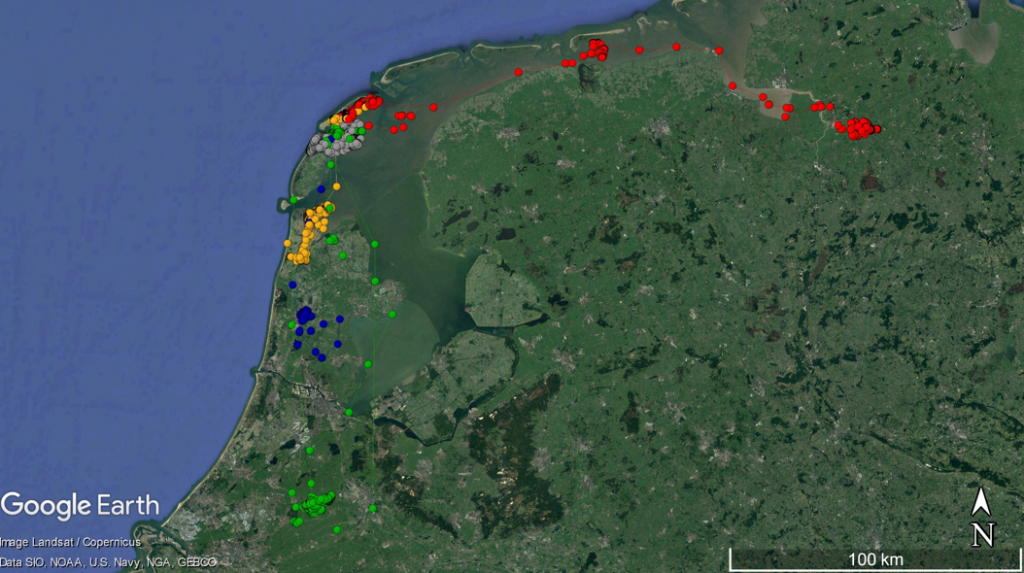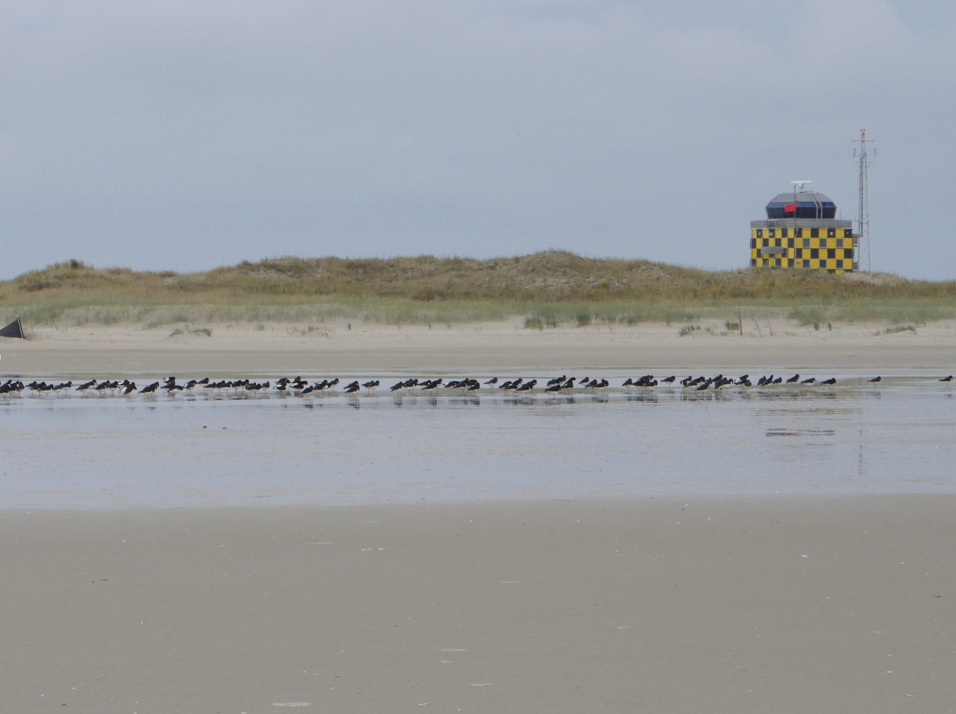Oystercatchers returning from inland breeding grounds
Sunday, July 23rd, 2017
Species: Oystercatcher
Project: Quantifying the effects of disturbance for wintering oystercatchers at the Vliehors (CHIRP)
The Wadden Sea is one of the most important wintering areas of the Eurasian Oystercatcher Haematopus ostralegus. From the Wadden Sea, the oystercatchers move to their inland breeding grounds in February or March. Most bird return to the Wadden Sea in July or August. Last winter, 20 oystercatchers were equipped with GPS trackers on the Vliehors for the CHIRP project. Many of those birds were ‘lost’ during the breeding season when they were inland. Over the last weeks, the first birds have returned to the Vliehors and the data from the trackers has been downloaded by the permanent antennae network on Vlieland.
Currently, five birds have returned to the large sandflats of the Vliehors. One of those birds, named Wietske (5445), was observed near Den Helder at the intertidal area Balgzand in March, but her breeding site could not be retrieved. Now it turned out she has bred near Schagen, about 12 kilometers south from the Balgzand area. Two other birds visited the western Dutch inland. One bird stayed in the vicinity of Heerhugowaard (5424), while another bird went to the meadow areas southeast of Woerden in the province of Utrecht (5437). Interestingly, this oystercatcher went early in the year for a short trip to Woerden, but returned after three days to the Vliehors area again. One oystercatcher bred in the Slufter on the Wadden Island Texel (5438), which is very close to the Vliehors. This was already suspected in winter, as the bird frequently commuted between the Vliehors area and the Slufter. Finally, an adult female oystercatcher (5346) spend the breeding season in Germany, close to the Jümmesee near the small village Detern. During the spring migration, stayed for a one-day stopover at the island of Schiermonnikoog.

Spring migration of oystercatchers wintering on Vliehors. Data 15 February 2017 – 10 May 2017. Trackers Red: 5346, Blue: 5424, Green: 5437, Grey: 5438, Orange: 5445.
The number of oystercatchers on the high tide roost are increasing daily and we expect more incoming oystercatchers during the coming weeks. Keep track of the oystercatchers with the near real-time data applet at the CHIRP project page.
Latest Highlights

Overwintering and foraging areas used by a 24-year old Eurasian spoonbill
Wednesday, April 18th, 2018

Lesser Black-backed Gulls from Schiermonnikoog enjoy their winter holiday
Tuesday, April 3rd, 2018

Oystercatchers returning from inland breeding grounds
Sunday, July 23rd, 2017

GPS tracker with SMS messaging
Monday, November 2nd, 2015

Ronny found back, three years after deployment of the UvA-BiTS GPS-tracker
Wednesday, July 8th, 2015

Lesser Black-backed Gulls feed on potato crisps in Moeskroen
Wednesday, November 13th, 2013

‘Vogel het uit!’ has won the 2013 Academic Year Prize
Tuesday, November 5th, 2013

Back in Europe: UvA-BiTS Honey Buzzard photographed at the Strait of Gibraltar
Wednesday, May 15th, 2013

UvA-BiTS database passes 10 million record mark
Wednesday, May 8th, 2013

Gulls pouring into the Kelderhuispolder colony
Wednesday, April 17th, 2013

To the Karoo and back: Mate replacement & GPS tracking study of an ousted eagle
Monday, March 25th, 2013

Meeting Montagu’s Harrier Edwin in Senegal
Wednesday, March 20th, 2013

Oystercatchers: Learning how and where to survive
Wednesday, August 29th, 2012

New GPS mini-tracker facilitates investigation into movement of smaller animals
Wednesday, July 4th, 2012

Over 5 million GPS fixes in the UvA-BiTS database
Thursday, June 21st, 2012

Tagged Lesser Black-backed Gulls return to Orford Ness
Wednesday, April 18th, 2012

Gulls spotted in their over-wintering areas
Wednesday, December 21st, 2011

The UK a top vacation destination in 2011
Wednesday, July 13th, 2011

A long way from home
Sunday, June 26th, 2011

Visiting Amsterdam for a day
Saturday, May 14th, 2011

Female deserts brood, male raises chicks
Friday, May 13th, 2011

Wintering range in Sierra Leone
Friday, May 13th, 2011

Camera watches foraging Oystercatchers day and night
Thursday, May 12th, 2011

The return of a bird presumed dead
Wednesday, May 11th, 2011

Texel gulls back from wintering areas
Sunday, May 1st, 2011

First Lesser Black-backed Gull returns to the breeding colony
Monday, April 13th, 2009


